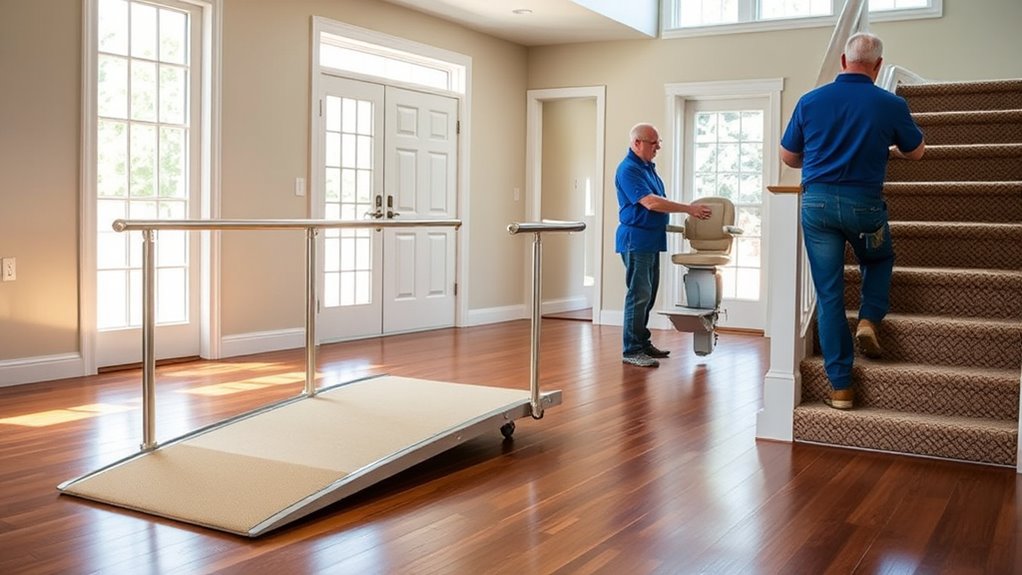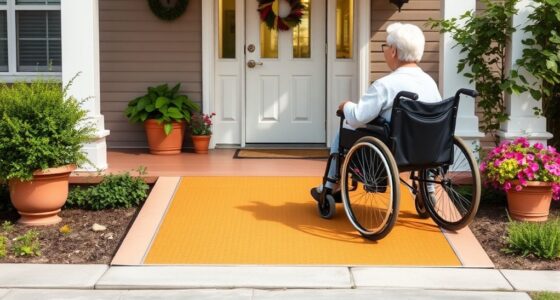To install ramps and stairlifts at home, start by evaluating your space to guarantee proper placement and safety. Make sure ramps follow the recommended 1:12 slope ratio and are wide enough for wheelchairs or walkers. Choose reliable, certified stairlifts that fit your home layout. Regular maintenance, safety features like handrails, and working with experienced installers help guarantee everything meets safety standards. Continue exploring to learn how to optimize your home for safety and accessibility.
Key Takeaways
- Assess available space and choose between straight or curved ramps and stairlifts for seamless integration.
- Ensure ramp slope adheres to 1:12 ratio for safety and comfort.
- Select sturdy, slip-resistant materials and secure installations to meet safety standards.
- Incorporate safety features like handrails, edge guards, and proper lighting for accessibility.
- Work with experienced professionals to ensure compliance with local codes and reliable, warrantied installation.

Making your home accessible is essential for safety and independence, especially if mobility becomes a challenge. When considering installation of ramps and stairlifts, you need to pay close attention to design considerations and safety regulations to guarantee the solutions are effective and compliant. Proper planning involves understanding the space available, the type of mobility aid best suited for your needs, and the specific requirements of your home environment.
Design considerations play a crucial role in selecting the right ramp or stairlift. For ramps, you should evaluate the slope to ensure it’s gentle enough for safe use, typically following the recommended ratio of 1:12 (one inch of height for every 12 inches of length). You’ll also want to consider the width of the ramp—aim for at least 36 inches—to accommodate wheelchairs or walkers comfortably. The surface should be slip-resistant, especially in wet conditions, to prevent accidents. For stairlifts, focus on the type of chair, the power source, and the mounting location. Whether you choose a straight or curved stairlift, the design must fit seamlessly into your home’s layout without obstructing other areas.
Safety regulations are non-negotiable and vary depending on your location, but generally, they set minimum standards to guarantee user safety. These regulations specify the maximum slope for ramps, the height of handrails, and the strength of the structure to support weight. Ensuring compliance means working with reputable installers who understand local codes and standards. It’s also wise to check for certifications and warranties to avoid future issues. When installing a ramp, secure anchoring and sturdy construction are vital to prevent shifting or collapse. For stairlifts, proper installation on a level, stable surface prevents any wobbling or instability during use.
In addition to meeting safety standards, think about accessibility features like handrails, edge guards, and adequate lighting. These elements greatly improve safety, especially for users with limited vision or strength. Regular maintenance is equally important; inspect ramps for damages or wear and keep stairlifts clean and functioning properly. Remember, the goal is to create a safe, reliable, and comfortable environment that promotes independence without compromising safety regulations. By paying attention to these factors, you guarantee the installation not only meets legal standards but also truly benefits your daily life, giving you peace of mind and greater freedom within your home.
Frequently Asked Questions
How Do I Choose the Right Type of Ramp or Stairlift?
To select the right ramp or stairlift, consider safety considerations like weight capacity and stability. Think about your specific needs, such as the space available and mobility level. Customization options are important too—look for features like adjustable height or folding designs for convenience. Measure your space carefully and consult with a professional to guarantee the equipment fits well and provides secure, reliable support tailored to your home and mobility requirements.
What Is the Cost Range for Installing Ramps and Stairlifts?
You’ll find that installation expenses for ramps and stairlifts vary widely, ranging from $1,000 to over $15,000 depending on your needs. While cost considerations might seem overwhelming, think of it as an investment in safety and independence. Basic ramps are more affordable, but custom solutions or stairlifts with features can increase costs. Always get quotes and weigh the long-term benefits against the initial expenses.
Are There Any Grants or Financial Assistance Options Available?
You can find various grant programs and financial aid options to help cover the costs of ramps and stairlifts. Check with local government agencies, non-profit organizations, and Medicare or Medicaid, as they often offer assistance for home modifications. You might also explore state-specific programs or community grants. Applying for these aid options can markedly reduce your out-of-pocket expenses, making your home more accessible and safer.
How Long Does Installation Typically Take?
Installation typically takes between a few hours to a full day, depending on the complexity of your setup. Your installation timeline can be affected by factors like the contractor you select and the specific requirements of your home. Make sure to choose a qualified contractor who can give you a clear schedule. Planning ahead guarantees a smooth process and helps you know what to expect during installation.
What Maintenance Is Required After Installation?
After installation, you should regularly perform cleaning routines to keep your ramps and stairlifts in good condition, using gentle cleaners and avoiding abrasive materials. Safety checks are essential—inspect for loose bolts, ensure the mechanisms work smoothly, and test safety features like brakes and sensors regularly. Keep the area clear of debris and report any issues promptly. Regular maintenance helps prolong the lifespan and guarantees safe use of your equipment.
Conclusion
By installing ramps and stairlifts, you’re transforming your home into a fortress of accessibility and comfort. This small upgrade can drastically improve your independence, making everyday tasks feel effortless—like gliding on air. Don’t wait for obstacles to become insurmountable; take action now and turn your home into a sanctuary that’s as welcoming and adaptable as you are. Remember, a few simple changes can make a world of difference—almost like rewiring your entire life for freedom.









